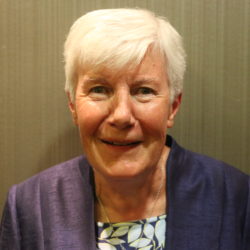Finding, Making, Walking
Walking the ancient Irish Pilgrim Pathways is becoming increasingly popular since 2013 when John G. O’Dwyer first published “Pilgrim Paths in Ireland – A Guide – From Slieve Mish to Skellig Michael” – since reprinted in 2014 and a new edition appearing in 2017. A guided walk on the St. Finbarr’s Pilgrim Path was offered as part of the lead-up to the World Meeting of Families in August 2018.

On my 69th birthday, while walking to Mass, I was wondering what I would do to celebrate my 70th year….I knew deep down that pilgrimage would feature and then the idea came to walk the five “passported” pilgrim paths in Ireland during the course of the year. I reread the relevant chapters of John G. O’Dwyer’s book and visited the website www.pilgrimpath.ie. The next step was to target family and friends and invite them to join me on some or all of the various pilgrim paths. I then contacted Ballintubber Abbey for the passports for all interested parties ranging in age from 13 to 83 years! As most of the walks are linear, two cars would be needed and so 4/5 people would be ideal – leaving one car at the end point and then travelling together to the starting point. Guided pilgrim path walks are available throughout the year and especially during Pilgrim Paths Week every Easter and also during National Heritage Week every August. However, the guidebook is very clear, the paths are really well-signposted and there is great freedom in choosing to walk in your own time.



Cosán na Naomh in West Kerry was out first venture on a bright clear December morning. This is a delightful 18km walk through the heart of the Kerry Gaeltacht starting at Ventry Beach and ending at the foot of Mount Brandon. Apart from the beautiful views looking over Cruach Mhárthain, the Three Sisters, Smerwick Harbour, Béal Bán Beach and the Blasket Islands – one also travels back in time with visits to the ancient Gallarus Oratory, the impressive ruins of 12th century Kilmalkedar Church and Caherdeargan Stone Fort. The walk is relatively flat – the only climb of any consequence begins after Kilmalkedar as you ascend the Reenconnell Ridge before descending to the narrow road that leads to Ballybrack carpark and the end of our first pilgrim path. We got the passports stamped in the tourist office in Dingle. Interestingly,when I did this walk a few months later with other friends, we were given a special Cosán na Naomh Certificate as well as the pilgrim stamp.
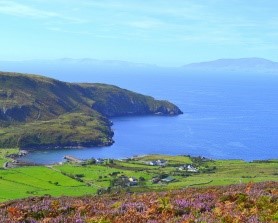
Our second pilgrim path, Cnoc na dTobar, is also in Kerry – quite near Cahirciveen on the Ring of Kerry. This ancient pilgrimage starts at St. Fursey’s Well and is short and steep (9km return) winding its way uphill with optional prayer and rest spots at the 14 Stations of the Cross that punctuate the path to the summit 690m (2,264 ft) where an impressive Celtic Cross, dedicated to Canon Brosnan, dominates the horizon. The views on the way up over Coonanna Harbour and Dingle Bay are but an appetizer to the spectacular views that unfold as one reaches the ridge. To get the passport stamp one is required only to walk to the 11th Station (6 km) but the extra kilometre and a half to the summit are not to be missed. The guidebook rightly claims that this is “Ireland’s most breathtaking vista” – the panorama encompassing the mountains, bays and inlets of Cahirciveen and Valentia stretching out to the Skellig and Blasket Islands is truly memorable and worth every step of the climb.
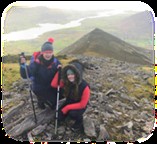
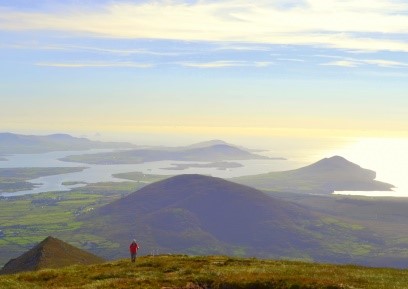
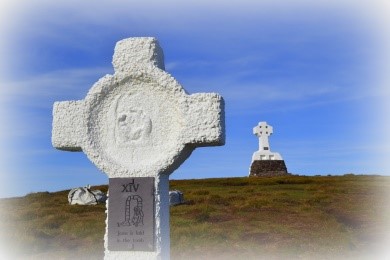
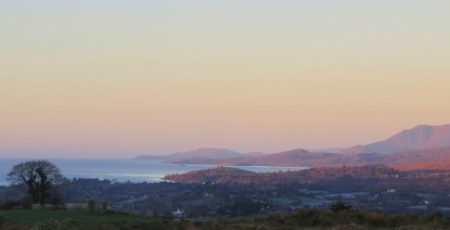
Slí Bharra (St. Finbarr’s Way) in West Cork is a 38 km two day walk – Day 1- from Top of the Rock near Drimoleague to Kealkill and Day 2 – Kealkill to Gougane Barra. The thermometer in the car registered -5.5 ° as we headed through the Cousane Gap around 7.00am on a cold clear frosty morning in January to rendez-vous in Kealkill before heading to our starting point at Top of the Rock. Again this walk has all the ingredients of a wonderful day’s walking – an easy stroll along the banks of the River Ilen to the historical Castledonovan before heading up the gentle slopes of Mullaghmesha via the magical Coomamore Lough with exhilarating views down over Bantry Bay and the Beara Peninsula. 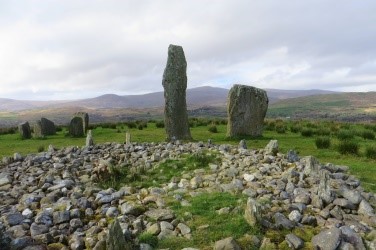
The descent to the Mealagh Valley is equally magical passing through young woodland plantations before crossing the Mealagh River. Again, the ancient Barnagowlane West Wedge Tomb and the impressive Kealkill Stone Circle take us back some 4,000 years to the Neolithic and Bronze Ages. As well as St. Finbarr walking this pathway one is also very conscious of O’Sullivan Beare and his historic march from Cork to Leitrim in 1603 which is now commemorated in Ireland’s longest walking trail, the Beara-Breifne Way – www.bearabreifneway.ie. By the time we tackled Day 2 Spring had appeared and the cherry blossoms were in bloom as we left Carriganass Castle in Kealkill passing by an interesting herd of hairy Scottish cattle en route up Lackavane Ridge. A beautiful walk along the ridge via Lough Namon leads to Foilastookeen – 500m (1,640 ft) and the first glimpse of Gougane Barra and St. Finbarr’s Island way down in the valley. Great care must be taken as one descends the well-signposted path down to the plaque welcoming us to this holy place of Gougane Barra. We gather in the oratory and thank St. Finbarr for bringing us safely to this haven of peace and tranquillity.


On a beautiful May morning we set off on Pilgrim Path No. 4 – St. Kevin’s Way in Wicklow. This is a 30km walk from Hollywood to Glendalough – it can easily be walked in a day but, because of the age profile of the participants, we had decided to take a break in Wicklow and walk it over two days – Hollywood to the Wicklow Gap and then on to Glendalough. St. Kevin’s Way is a nice gentle walk through glens and quarries along the banks of the King’s River and the Glendasan River, along boardwalks, following in the footsteps of St. Kevin to the monastic site of Glendalough. Fittingly, we concluded our pilgrim walk with Evening Prayer in the Hermitage Centre and a visit to the Meditation Garden “a place where nature, scripture and Glendalough’s history are combined in harmony…delighting the eye, comforting the soul and leading pilgrims to prayer and a deeper awareness of God.”
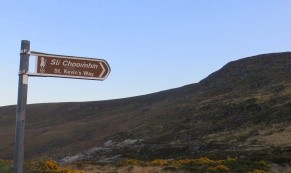
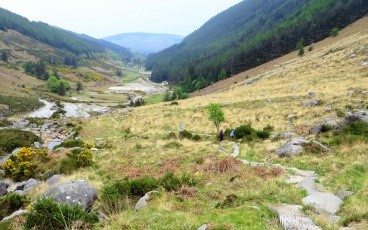
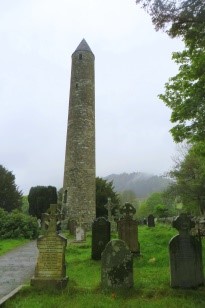
We had saved the jewel in the crown of the pilgrim paths until the end. Fr. Frank Fahey, in the introduction to “Tóchar Phádraig – A Pilgrim’s Progress” (Ballintubber Abbey Productions 1989), describes the Tóchar, not only as a spiritual pilgrimage but also “a cultural and historical journey down through the ages”. Tóchar Phádraig is a 35 km ancient pilgrim path from Ballintubber Abbey to Croagh Patrick. The pilgrim path was reopened in 1988/89 by Fr. Frank. In 1995 a few of us walked the full pilgrim path leaving Ballintubber Abbey at 9 am reaching the summit of Croagh Patrick at 6 pm. This time we decided to take two days – going from Ballintubber to Aghagower and then on to Croagh Patrick the following day. As we had only one car Fr. Frank kindly offered to collect us at Aghagower which we greatly appreciated. The Tóchar is a real pilgrim experience. Fr. Frank accompanies pilgrims to the starting point and sends them on their way with a blessing. Some elements of pilgrimage appear on signs all along the way – Faith, Silence, Change of heart, Community, Share and Celebrate etc. – a constant reminder of the importance of the journey inwards. The Tóchar is also somewhat more penitential as numerous stiles – 100+ – have to be negotiated along the way. To qualify for the passport stamp it is not required to go to the top of Croagh Patrick – you climb up from the south to the shoulder between Crot Mountain and Croagh Patrick and you can follow the usual pilgrim trail down to Murrisk car park. However, as in Cnoc na dTobar, the effort in continuing upwards to the summit is well rewarded especially on a fine day.
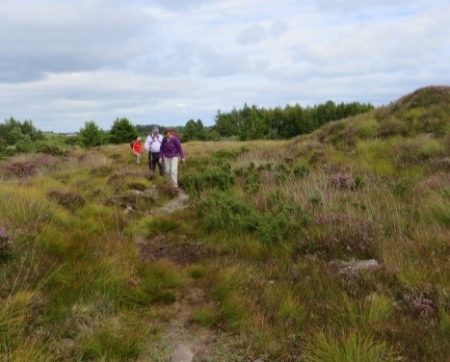
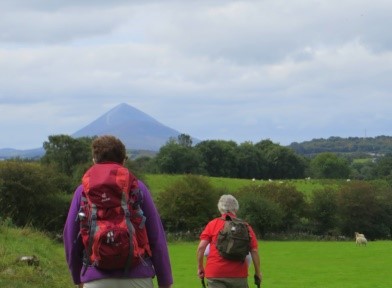
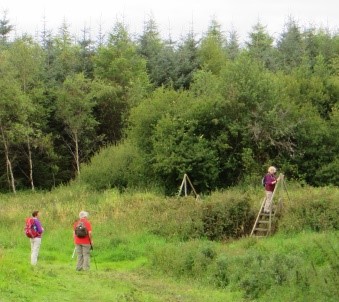
Having completed the five Pilgrim Paths and obtained the necessary stamps on the Pilgrim Passport you are awarded a Teastas Oilthreachta (Pilgrim Certificate) from Ballintubber Abbey – a beautiful certificate confirming that you have walked in the footsteps of St. Brendan, St. Fursey, St. Finbarr, St. Kevin and St. Patrick. You also get a special mention in the list of Críochnóirí (Finishers) in the website. Many more Pilgrim Paths are being rediscovered all over Ireland – St. Declan’s Way, St. Brigid’s Way etc offering opportunities for ongoing exploration of outward and inward journeys in keeping with the thinking of St. Columbanus who once said “I am moving from the day of my birth ‘til the day of my death” and mindful of our Chapter 2018 logo – Pathways –Finding, Making, Walking.
Go n-eirí an bother leat! May the road rise to meet you!
Ann Lenihan rsm
Southern Province

